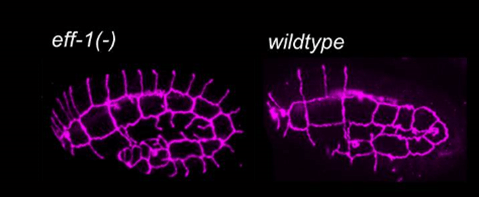Connected to Life
Technion researchers decipher the mechanism of cell-cell fusion, which is vital to embryo formation and development
Technion researchers have deciphered the mechanism of cell-cell fusion, which is vital to basic life processes, including embryo formation (sperm-egg fusion), fetal development and growth of tissues such as muscle and bone. This process is apparently involved in inflammatory and cancerous processes as well. The study was published in the journal Cell Reports.
Prof. Beni Podbilewicz of the Technion Faculty of Biology, who led the study, explains that “it is clear that such a critical process must be closely controlled in space and time. However, despite its importance, this control mechanism has not yet been completely deciphered, and that was our mission in this study: understanding the genetic and cellular mechanisms responsible for controlling fusion.”
Cell-cell fusion is a process in which two cells cling together, their membranes merge in the contact area, and the two cells become one. First the outer layers of the cell membrane fuse, and then the inner layers.
Prof. Podbilewicz, who has been studying the above mechanism for quite some time, discovered that the key player in the process is EFF-1, a developmental fusion protein. Prof. Podbilewicz said, “We see this protein as a sculptor, since in this process it sculpts cells and organs.”
In the current study, conducted in Prof. Podbilewicz’s laboratory by Dr. Ksenia Smurova, it became clear that successful fusion requires the presence of EFF-1 in both cells that are destined for fusion. Moreover, the researchers found that in order for fusion to occur, the EFF-1 protein from both cells must meet in the contact area between the cells. However, in order to prevent excessive fusion that can cause the death of the entire organism, these proteins must be kept away from the cell membrane and reach it only at the desired stage. Dr. Smurova discovered that two proteins (Rab5 and dynamin) are responsible for constantly keeping the EFF-1 away from the cell membrane.
The current study at the Technion, like many other studies in this field, was carried out on the worm (nematode) C. elegans. This microscopic worm has many advantages from a research perspective, including being the first multi-cellular organism whose genome has been fully sequenced. In addition, it is a transparent worm whose organs are visible in non-invasive photography. Several Nobel Prizes have been awarded to scientists for studies with C. elegans, which began in the 1960s.
“After deciphering the mechanism in C. elegans, we examined the action of EFF-1 on cells from insects and mammals, and we have shown that it leads to fusion in these cells as well. The mission of the future is of course to examine the action of this gene in human cells and to determine whether controlling the expression level of this vital gene will enable us to treat infertility, prevent defects in embryonic development, inhibit inflammatory and cancerous processes and more. “
Prof. Podbilewicz, who grew up in Mexico, came to Israel after graduating from high school. After spending some time at Kibbutz Nir David, he returned to Mexico, completed his undergraduate studies in Mexico City and went on to Yale for his doctoral studies and Cambridge for his postdoc. After his marriage, he immigrated to Israel and has been a faculty member of the Technion Faculty of Biology ever since. His main hobby – singing – has been part of his life since he was 15. He sang with the Yale Glee Club, Yale Camerata and Cambridge Philharmonic Society, and is now a tenor with the Madrigal Singers Ensemble.
For the full article, please click here

Wildtype embryo shows many cells that fuse during normal development. In the
mutant eff-1(-) embryo cells of the skin fail to fuse. Apical Junctions in magenta
show the borders between cells of the skin. In healthy wildtype embryos, the
junctions disappear when they fuse




